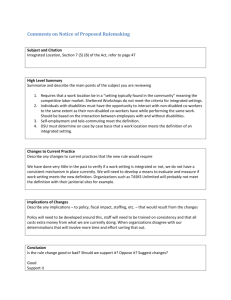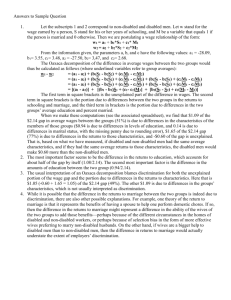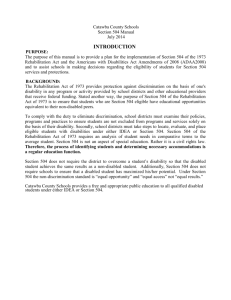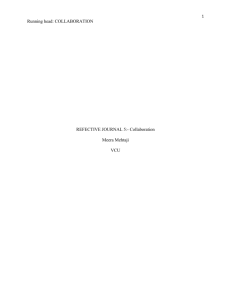Position Paper - WordPress.com
advertisement
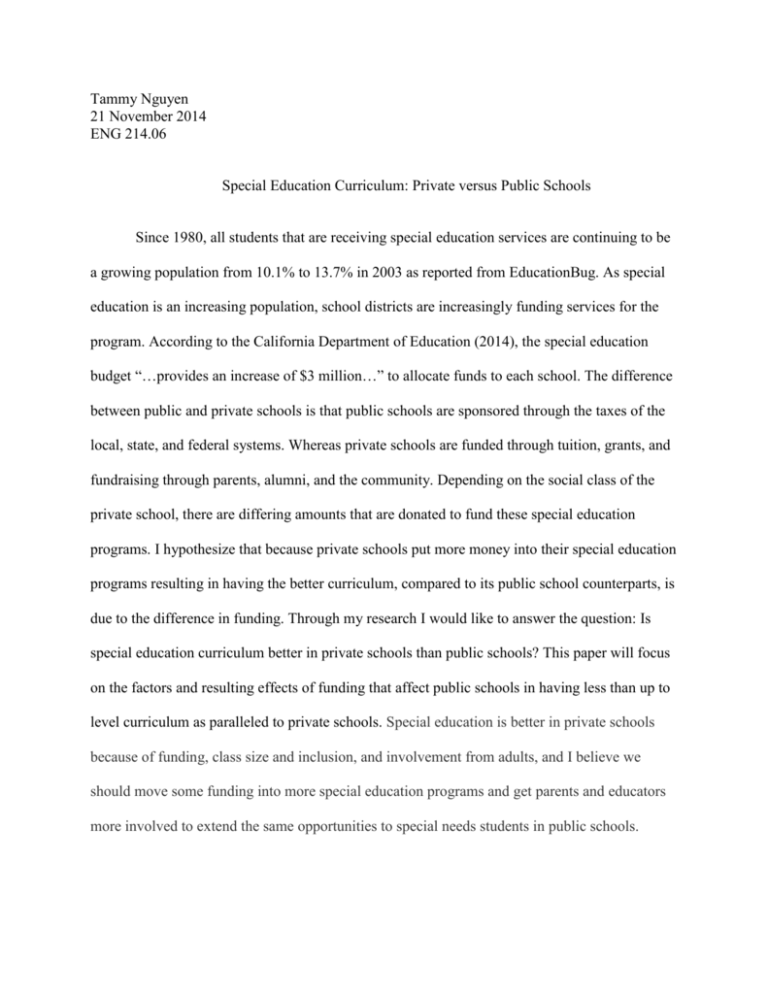
Tammy Nguyen 21 November 2014 ENG 214.06 Special Education Curriculum: Private versus Public Schools Since 1980, all students that are receiving special education services are continuing to be a growing population from 10.1% to 13.7% in 2003 as reported from EducationBug. As special education is an increasing population, school districts are increasingly funding services for the program. According to the California Department of Education (2014), the special education budget “…provides an increase of $3 million…” to allocate funds to each school. The difference between public and private schools is that public schools are sponsored through the taxes of the local, state, and federal systems. Whereas private schools are funded through tuition, grants, and fundraising through parents, alumni, and the community. Depending on the social class of the private school, there are differing amounts that are donated to fund these special education programs. I hypothesize that because private schools put more money into their special education programs resulting in having the better curriculum, compared to its public school counterparts, is due to the difference in funding. Through my research I would like to answer the question: Is special education curriculum better in private schools than public schools? This paper will focus on the factors and resulting effects of funding that affect public schools in having less than up to level curriculum as paralleled to private schools. Special education is better in private schools because of funding, class size and inclusion, and involvement from adults, and I believe we should move some funding into more special education programs and get parents and educators more involved to extend the same opportunities to special needs students in public schools. The costs per student of a disabled versus a non-disabled student are drastic. According to the “Statewide Average Spending Per Pupil, 2010-11” in Figure 7, local education agencies, or LEA, spent approximately $9,600 per non-disabled student. Total funds for a student with disabilities, or SWD, was more than twice as much sitting at $22,300. Students that have less severe disabilities also have lower costly services. Comparing private schools to public schools, there are more students entering into public settings because tuition for education is cheaper than that of private schools. In this case, there is a need for more aid from governmental institutions to provide for all students in public schools, in turn making education for special education students less top-tiered. Private schools are able to raise the funds for their students through the various donors that are appreciated through the school community. Budgeting issues limit what certain programs are able to do and not do. The journal article “Private Vs. Public Higher Education Budgeting” states that the limited budget of public resources in public institutions must be allocated among many of the institutions’ needs. The requirement of allocation of resources in public settings is one of the many factors that have affected the funding that special education curriculum has received. Because public institutes must adhere to the regulations set and controlled by a governmental organization, specific programs are given their apportioned financing which may or may not positively assist special education programs depending how much is assigned. Assistance through laws being enacted and programs being started have made strides to educate students. According to The Individuals with Disabilities Act (IDEA) of 1997, “early intervention, special education, and related services to children with disabilities” is provided through this federal law (Center for Parent Information and Resources). In other words, IDEA provides plans to schools of how instructional placement and curriculum is dependent mainly on the age and function level of the student and how severe their disability is. The Individuals with Disabilities Act is a factor in which public and private schools focus on the student themselves. Within private settings, approximately 3.4% of students with special disabilities are being assisted (Beamer). Special education curriculum in public schools is based on individualized education programs (IEPs) (Elhers). A team of the students’ parents, special education teachers, and an administrator come together to determine where the student is in need of assistance in their educational performances. Public schools are more restricted in their special education programs as compared to private schools because of their allocations of funding. The most common factor concerning both public and private schools with their special education programs is the interaction that is involved in attempting to modify the program. Since public schools are subsidized through the government, state, and local taxes there is less of a voice coming from the parents and teachers of the school. At a public school, the study and work is more standardized in turn resulting in the education of all the students very similar. Special education students would have a difficulty learning through a standardized lesson because of the type of severity of the disability they may have. On the other hand, through private backing in private schools, those who give donations are allowed to request that their donations go to a specific program or issue or to the school in general (EducationBug). The investment put into private schools makes programs like special education programs more comfortable for and specific to the individual student. More severe students of specialized education in public schools are affected mainly if they are not able to keep up with the students who have less severe disabilities. Each particular need of the student is increasingly voiced through private special education in the case if the setting of the classroom is smaller (EducationBug). With an average of a smaller class size in private schools, the learning atmosphere for students is slower pace while still in a challenging environment (Walker). Demographics in private classes versus public classes are smaller than that of public. Public classes that contain more students must cater to the learning curve instead of each students’ learning rate. The difference in the learning curve and the learning rate of students is that the curve is directed towards the population of the class whereas the learning rate is that of each individual student. While each student learns differently based on their learning type like auditory, visual, or kinesthetic, the teacher may not teach the class the way it is easier for a public student to learn the lesson. Individualized and group learning is also an asset used within private school settings. With IEPs also used at private schools, some children are placed in separate classrooms with specialized teachers to one-on-one learn (Dwight). Continuing with separate classrooms, it also happens that when the students are separated because of learning or behavioral disabilities, they do not have much interaction with other special students and mainly non-disabled students. Public funding indirectly assists in the interaction between disabled and non-disabled in that there is some type of contact between the groups of students. On the opposite end of separate classrooms, private schools embrace inclusion. Inclusion places students of both disabled and non-disabled in a classroom together in order to normalize and learn toleration of the special needs of a student to that of a non-disabled (Dwight). Under Title I, B, 612, a, 5 of IDEA, the act refers to a least restrictive environment summarizing that depending on the severity of the disability of the student, educational institutions must include the students in regular classes (IDEA). For special education students, it is more difficult for them to juggle all that is going on because of their disabilities. It is common knowledge that a special education student requires more attention than a non-disabled student. This could be seen through examples of students that have a more severe type of disability. In a classroom setting, a non-disabled student is able to think for himself and what is and is not appropriate to do, whereas a disabled student whose brain is not developed correctly, would make him do uncontrollable movements. It is more dangerous when the disabled student has uncontrollable movements such as the example because they need to have constant supervision. The more support whether it be educational, emotionally, or physically, every special education student deserves to have optimal outcomes. Seeking the best practices through methods of interaction and observation specially educated students would be able to have the best curriculum that is suited for them no matter the price that is put on their education. The diversity of each student enables the community of their school and classrooms to exercise different learning strategies. Involvement from the team of parents, guardians, and school districts to develop a qualifying education program to meet the needs of the special educated student (Spectrum Center). To get a better picture on the issue, I think teachers and administrators need to refocus curriculum to each special education students’ need and level of learning. Through many positive and negative aspects of private schools versus public schools, there seems to be more pieces of private schools that outweigh public schools. It has been studied and found that private schools, because of the amount of endowment the school receives, there is a more substantial positive outcome for students of special needs. Better funding towards public school systems and their special education programs will better the students’ outcomes of learning. The separate school systems of private and public have differentiated ways of teaching because of the allowance of funding and the ability to work with what is given to the school. Works Cited Beamer, S. (2011). Private vs. public higher education budgeting. Planning for Higher Education, 40(1), 7-11. Center for Parent Information and Resources. (2014, May 1). Retrieved November 20, 2014, from http://www.parentcenterhub.org/repository/idea/ Dwight, V. (n.d.). Special needs programs and schools: A primer. Retrieved November 20, 2014, from http://www.greatschools.org/school-choice/special-education/6997-specialeducation-special-needs-learning-disabilities.gs Education Budget - CalEdFacts. (n.d.). Retrieved November 20, 2014, from http://www.cde.ca.gov/fg/fr/eb/cefedbudget.asp Elhers, R. (2013, January 3). Overview of Special Education in California. Retrieved November 20, 2014, from http://www.lao.ca.gov/reports/2013/edu/special-ed-primer/special-edprimer-010313.aspx#6 Elizabeth, M. (n.d.). Special Education Statistics. Retrieved November 19, 2014, from http://www.educationbug.org/a/special-education-statistics.html IDEA - Building The Legacy of IDEA 2004. (n.d.). Retrieved November 20, 2014, from http://idea.ed.gov/explore/view/p/,root,statute,I,B,612,a,5, Walker, R. (1999, July 26). Public Education vs. Private Education. Retrieved November 20, 2014, from http://web.stanford.edu/class/e297c/poverty_prejudice/school_child/public.htm Welcome to Spectrum Center. (n.d.). Retrieved November 20, 2014, from http://www.spectrumschools.com/Home.aspx Grade level descriptions: A “high pass” goes above and beyond for a majority of the grading criteria. It may have a few minor surface errors (nobodys perfect), but it stands out because of its handling of both content and language. It is well organized, not just following the ethnography format we’ve discussed, but reflecting a logical and smooth development through that structure, connecting main points to each other and back to the controlling idea. Its focus is clear and its development is strong and interesting, providing full and clear explanation of the study’s results supported with evidence and analysis. The content is insightful, probing, thoughtful, even critical. A “pass” meets and/or exceeds the majority of the grading criteria, but may have one or two noticeable weaknesses. It is similar to the “high pass” except that it lacks some of its distinguishing features. A “low pass” adequately fulfills its purpose, meeting most of the grading criteria and includes many commendable features, certainly including a central idea and recognizable organizational structure. It provides support of its thesis, that may need to be strengthened or reorganized to make a more logical, seamless connection. May contain some isolated errors in grammar and punctuation or misspellings - none of which obscure the writer’s meaning. A “revise and resubmit” is often the result of a good faith effort by the writer, but for many possible reasons may have gone astray, leaving out some of the necessary criteria to be eligible for a grade. Criteria for: Assignment fulfillment: 1500-1800 word paper that uses research to support a logical argument HP P RR comments X X Central idea/thesis: -Clearly articulated in the paper’s introduction -Sets forth an “argument” pertaining to the issue you’ve researched -Is invoked throughout the paper to guide the supporting evidence Organization: -Paper is structured around your main claim and supporting claims (NOT on sources from your research) LP X Maybe you should try to make your argument a little clearer in the intro . At first I didn’t know you were arguing for private schools -Topic sentences give a clear picture of the subclaim to be supported in each section -Transitions move the reader along by connecting ideas and sections -Conclusion restates your argument and the subclaims that you used to support that argument, and leaves the reader with something to do or think about Support: -Subclaims logically support the main claim -Research is used strategically as evidence for subclaims -Clearly attributes the words/thoughts of others through summary, paraphrase and quotation -Responds to the claims of at least 3 sources X Sentence craft: -Sentences are well focused with strong subjects (it is clear who is doing what in each sentence) -Sentences flow together (each is connected to the sentence before and after, so nothing comes out of left field) -Sentences follow rules of style and grammar -Employs a variety of sentence types X Clarity/presentation: -Minimal formatting errors (meaning the look of your text is X -I like how you had a lot of resources -I do feel like you can find way more stronger examples on why private schools are better for special education consistent and punctuation and mechanics are error-free) -Citations consistently follow whichever style you choose (MLA, APA or Chicago) -Works cited/reference page is properly formatted to your chosen style (see above) -Sentences are free of meaning obscuring errors and have minimal surface issues (things missed in proofreading) -Word choice is concise and sophisticated
